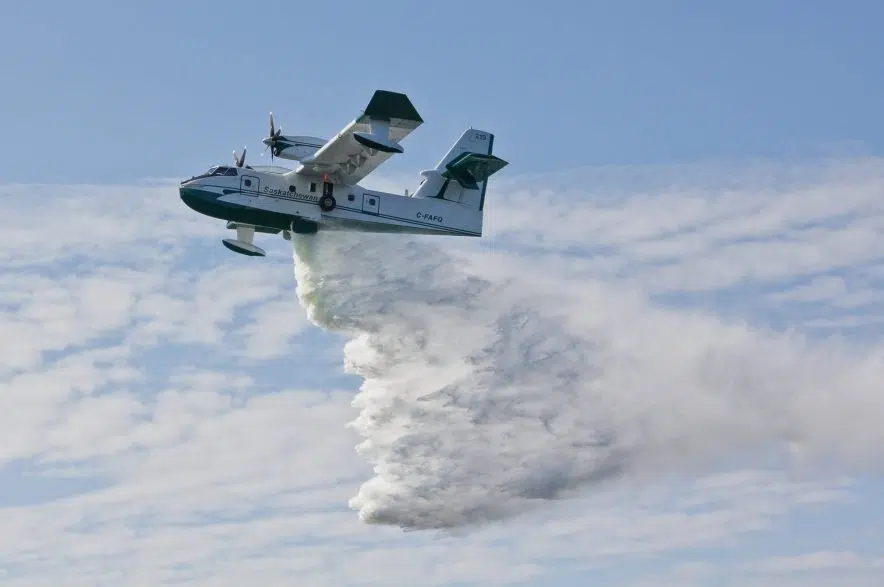Wildfires continue to rage in northern Saskatchewan, forcing hundreds of people to evacuate their homes.
The Saskatchewan Public Safety Agency has recorded 168 wildfires so far this year, nearly twice the five-year average of 87.
As of 4 p.m. Thursday, there were 25 active fires in the province. Seven were classified as contained, one was classified as “protecting property,” 12 were under ongoing assessment and five were considered not contained.
In a media briefing Thursday, SPSA officials said they weren’t exactly clear on how much structural damage had occurred as a result of the wildfires.
“We are continuing to assess the fire and any loss values around these fires,” said Bryan Chartrand, the SPSA’s executive director of land operations.
“Due to smoke, visibility has been very challenging for us to get out and to do these assessments. With the wind changing (Thursday), that will open up portions of the fires, so we will be doing those assessments and documenting and providing that information when available.”
Chartrand said that to his knowledge, nothing has been reported yet in terms of damage but there are always concerns of structural damage that the SPSA isn’t aware of.
There isn’t a clear timeline for when evacuees might be able to return home, but Chartrand said it would take a week at the earliest barring a significant rain event.
“With the current weather conditions and the dry conditions we’re dealing with and the size of these fires, it’s going to take some time for us to get them contained, so I don’t have a magic number. But it won’t be anytime in the near future,” he said.
Chartrand said power had been restored to the communities that lost power earlier this week.
Special air quality statements remained in place for areas of western Saskatchewan, but had been lifted for areas around Regina and Saskatoon.
Support efforts
The SPSA is providing support for evacuees in the form of food, clothing and shelter and “other services as necessary.”
In partnership with the Meadow Lake Tribal Council, 760 people in Lloydminster have received that support. They were evacuated from Dillon, St. George’s Hill and Michel Village.
So far, 220 people from English River and Patuanak have received help in North Battleford.
And in Regina, 94 people from Buffalo River Dene Nation, Île-à-la-Crosse and Jans Bay have been assisted.
“I want to remind everyone also about the toll-free information line that was launched (Wednesday) for those who have been evacuated from their communities as well as those who have questions about the provincial fire ban,” said SPSA fire commissioner Marlo Pritchard.
“That number as a reminder is 1-855-559-5502.”
On Thursday, Premier Scott Moe responded to concerns some have voiced about the province’s evacuation system. He suggested the possibility of making improvements.
“We’re doing everything we can to get our grocery and fuel trucks into those communities north of the fire line, prioritizing them and getting them through when we can, but we are in active discussions and will (hopefully) come to a decision quickly on how we can further support northern communities that didn’t have power, weren’t able to leave and did lose some of the food that was in their homes,” Moe said.
He said the province will have more to say within the next 24 to 48 hours.
Road closures
There are currently five road closures in the northwestern part of the province due to wildfire and smoke, including:
- Highway 925 from the junction with Highway 155 to Dillon; Pritchard said barricades are being staffed at that location;
- Highway 155 from the junction with Highway 165 to Buffalo Narrows;
- Highway 914 from Churchill River to the Key Lake minesite;
- Highway 165 from the junction of Highway 910 to Highway 914; and
- Highway 910 to Besnard Lake.
Major fires
The Vermette fire is currently 45,000 hectares in size and is located southwest of Dillon, according to Pritchard. Nearby communities include Dillon, St. George’s Hill and Michel Village.
“It’s being resourced by Type 1 and Type 2 firefighters, heavy equipment, helicopters and air tanker support,” Pritchard said. “Crews continue to serve as value protection units and good progress has been made on this fire.”
The Shaw fire is currently 84,802 hectares and is southeast of Dillon. The nearest community is Buffalo Narrows.
Pritchard said it is also being resourced by Type 1 and 2 firefighters, heavy equipment, helicopters and air tanker support.
“Crews are assessing visibility and servicing value protection units and they continue to work on dozer guards,” Pritchard said.
The Smith fire is 103,624 hectares and is located north of Pinehouse.
“The SPSA continues to monitor the fire using detection aircraft and is assessing values that might be threatened,” Pritchard said.
The Wistigo fire is currently 21,362 hectares and is located southeast of Pinehouse. It’s also being managed by Type 1 and 2 firefighters, heavy equipment and helicopter support.
Crews are working to extend “cat lines” and water tenders following the northeast side of the fire. They’re also working to prevent its progression to the southeast side with air tanker support.
Pritchard also said the SPSA will continue to assess whether the fire has crossed or is crossing Highway 165.







